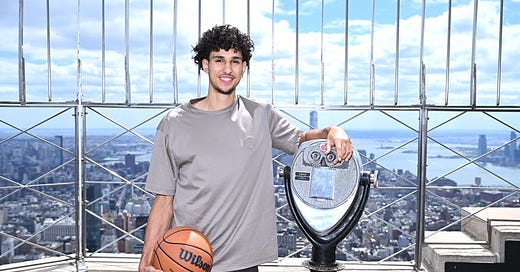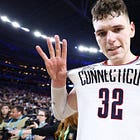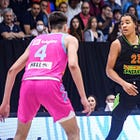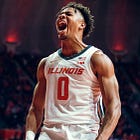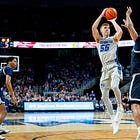2024 NBA Draft Grades — First Round
With the first thirty selections in the books, it's time for a quick grade for each pick. As always, with an explanation and depth. Up to the second round, we go!
I have never been more excited for an NBA Draft than this year. Before we start, please remember that the 2025 NBA Draft will be covered in much more volume and detail from my side. On top of that, I plan to spend more attention on my specialty: European prospects. So before we start, consider subscribing.
Consider to Subscribe
With over 80 in-depth scouting reports containing over 2,500 words, Ersin’s NBA Draft Newsletter has become a ‘one-stop-shop’ for NBA Draft content for many. While growing the newsletter from zero to over 400 subscribers, the goal is to continue growing it by valuing quality over quantity.
The draft should be accessible to everyone. With bigger media outlets focusing on the ‘top guys’, I want to create an even playing field by focusing on the less-coveted prospects. Every year has success stories outside the lottery, so why not be among the selective people who saw it coming from miles away?
My goal for the 2025 NBA Draft is to have over 100 in-depth scouting reports. Trust me, I get a thrill from every single subscription. Eventually, the goal is to make the newsletter cost-neutral, thus forcing me to change to the scouting reports being available to paying subscribers. Thank you for being so supportive, here’s 20% off on me.
And if you want to give Ersin’s NBA Draft Newsletter an additional boost, please consider providing an amount you choose as a Team Ersin Demir member.
Ersin's NBA Draft Newsletter is a reader-supported publication. To receive new posts and support my work, consider becoming a free or paid subscriber.
The Lottery
1 — Atlanta Hawks: Zaccharie Risacher (2005, SF)
Grade: B+
The Hawks bet on long-term potential with Risacher. His way above-average three-point shooting along with his good athleticism and great mobility could turn him into one of the league’s better wing scorers. There’s one big need for Risacher to succeed: improve his offense creativity.
While settling into a role his entire life, the Hawks are ready to give him all the reps he needs to improve his handle and self-created scoring opportunities. His high floor makes him a good pick for them. But there’s still a risk the offensive creativity will never develop due to Risacher’s modest approach to the game. But that can change once he’s accustomed to the American way of basketball.
2 — Washington Wizards: Alexandre Sarr (2005, C)
Grade: B+
Washington gets their guy in Sarr. While their roster needs multiple positions alongside their likelihood of staying bad for a few more years, the Wizards bet on long-term potential. With Sarr, they have a potential defensive star on their hands.
As a true seven-footer, Sarr can ultimately guard every position on the court with his great mobility and defensive footwork. His being an All-Defensive player in his career is almost certain. However, his role on offense is an area of attention for Washington. Sarr has stated that he wants to play as a four, which makes improved handles and shot-making a crucial area in his development. He’s an average play-finisher out of the pick-and-roll at best, with his hands and touch around the rim being an area he wasn’t consistent.
Intangibles matter too. And with Sarr moving from France to Spain to then following up with playing in Georgia, USA whereafter playing in the NBL before landing in Washington. Adversity and quickly adjusting to a new environment is what makes Sarr so strong off the court.
A great pick by the Wizards.
3 — Houston Rockets: Reed Sheppard (Freshman, SG)
Grade: B-
The Rockets address their need for three-point shooting on the perimeter while adding a defensive menace in Sheppard. In terms of his feel for the game, he’s one of the better players in this class. In their future point guard Amen Thompson, the Rockets secure a stable offensive rating by going for Sheppard’s ability to put less focus on Thompson’s developing three-point shooting.
With a defensive-minded coach in Udoka, it’s easy to see why Houston likes Sheppard so much. With the Rockets holding a team option for Fred VanVleet’s contract, it’s clear who they will eventually replace. The swing skill for Sheppard is to develop his playmaking to eventually take on point guard duties, while he can bank on his good connective passing in the early stages of his career.
4 — San Antonio Spurs: Stephon Castle (Freshman, SF)
Grade: A-
With Wembanyama ascending to already one of the league’s best defenders, the Spurs continue their tradition of adding high-feel players who thrive on making winning plays. Castle started the year with an injury while fighting himself to a good rotational role at Connecticut.
His connective passing, defensive stops, and great cutting make him a good connecting guard for the NBA. His touch around the rim while being able to serve as a secondary creator in the pick-and-roll gives the Spurs much-needed additional playmaking alongside Vassell, another franchise cornerstone.
Castle’s an elite prospect in terms of his point-of-attack defense, which is the biggest value the Spurs are getting while potentially boosting their defensive rating.
5 — Detroit Pistons: Ron Holland II (2005, SF)
Grade: A
The Pistons add a potential superstar in Holland II. His combination of burst, explosiveness, and elite athleticism make him one of the more dangerous future scorers in the NBA. Early on teams can scheme his interior threat away by forcing him to shoot threes by packing the paint. Adding a jumper will elevate his career to stardom, with the Pistons needing offensive creativity and another building block to put less pressure on Cade Cunningham.
Despite the odd fit with Ausar Thompson and Jaden Ivey, the Pistons are valuing long-term talent over fit, and that is the way to go if you’re a heavy rebuilding team. By averaging close to twenty in the G League, Holland II gives a good feasibility test in terms of his scoring prowess translating in the NBA early on in his career. He looks like a lock for the All-Rookie First Team if he gets the opportunity to play good minutes.
6 — Charlotte Hornets: Tidjane Salaün (2005, PF)
Grade: A-
The Hornets can bet for long-term potential with Salaün, who will likely play have stints in the G League. In my early-season scouting report on him, I called him the “potentially the best French player in this draft”. Salaün plays with that much-needed ‘F-you’ attitude where he doesn’t care for anything that comes in his way. He’s a winner, and he’s potentially an All-Star but has many things to figure out.
He’s a bruiser-typed forward with guard skills who is still filling his frame. With decent handles, Salaün fits the fast-paced offense the Hornets are playing. In terms of fit and long-term potential, Charlotte got themselves a potential home-run pick if they can slowly develop him into becoming another high-scoring option alongside Brandon Miller.
7 — Portland Trail Blazers: Donovan Clingan (Freshman, C)
Grade: A-
Portland commits to Henderson and Simons in the long term by giving them an interior dominance factor in Clingan. He’ll be the next American center on Team USA with his excellent feel for the game as a passer and roller. He’s instantly improving their rebounding while immediately improving their defensive rating. In a high-caliber pick-and-roll playmaker in Henderson, Clingan is another candidate to become an All-Defensive player in the future.
His lack of free-throw shooting bears worries for late-game situations. However, his touch is fixable, while in a dynamic and uber-athletic backcourt, Clingan’s need to shoot threes is being taken away by the Trail Blazers. A homerun pick for Portland here.
8 — Minnesota Timberwolves: Rob Dillingham (Freshman, PG)
Grade: A
This was the hill I was ready to die on. Dillingham makes too much sense to be left outside of the top ten. Minnesota gets the best ball-handler in the last two drafts combined. He’s the most offensively gifted player in the class, and his offensive creativity will open up everyone’s game.
His live-dribble passing and rim pressure will lead to the Wolves continuing to add shooters to fill their roster. In a generational defender in Gobert and an up-and-coming defensive star in McDaniels, Dillingham will have enough pieces around him to cover up his defensive deficiencies. The Wolves add another offensive juggernaut with Anthony Edwards being relieved with the help he is getting.
9 — Memphis Grizzlies: Zach Edey (Senior, C)
Grade: B-
The Grizzlies only had one option: fill their center rotation. In Edey, they get the back-to-back National Player of the Year. He will instantly fix the Grizzlies’ rebounding issues. Conditionally he’s in superb shape where it’s likely that he can play heavier minutes in the NBA while starting around 20 to 25 per game. With one of the best defenders in the league in Jaren Jackson Jr., the Grizzlies add another defensive anchor to the mix.
His role will consist of a play-finisher while bullying mismatches in the post. With the Grizzlies’ rim pressure and quick execution, they can afford to not focus on transition basketball and approach a halfcourt-heavy scheme which is needed to properly use Edey.
10 — Utah Jazz: Cody Williams (Freshman, SG)
Grade: B-
The Jazz were unlucky on draft night and missed out on several options. However, they deserve credit for sticking to their principles and continuing to add talent to their roster. In Cody Williams, they get a good ball handler who thrives on making winning plays as a point-of-attack defender while he can play in a low-usage role as an interior scorer.
He’s not an explosive athlete by any means, but his great size and length combined with his craft make him a threat as a closeout attacker. His touch around the rim is among the best in this class, and that might be an understatement as the Jazz continue to add paint touches with Sexton already standing out in that category. The most crucial area of development for Williams is to improve as a playmaker to eventually earn the role of the secondary ball handler.
11 — Chicago Bulls: Matas Buzelis (2004, PF)
Grade: B+
The Bulls get their hometown kid. Buzelis is an empty blueprint waiting to be prepared for his NBA role. He’s a great athlete who improved his handles during his year in the G League. While being a feared interior scorer in high school and the summer circuits, Buzelis matured his game and embraced his role as a lower-usage forward at the Ignite. His feel for the game as a weakside rim protector alongside his developing three-point shot give him a clear role on day one.
The swing skill for Buzelis is to accept an off-ball role while working on his off-ball defense. If he can be a better decision-maker on defense, likely, Buzelis will likely eventually grow into the higher-usage scoring wing he wants to be. And that’s an archetype the Bulls need.
12 — Oklahoma City Thunder: Nikola Topić (2005, PG)
Grade: A
The Thunder made themselves contenders by grabbing Caruso in the Giddey trade. Adding a high-end playmaker to complement their star in Gilgeious-Alexander is a great move by Presti and his staff. Topić is one of the best interior scorers in terms of his craft and touches at the rim, while his pick-and-roll playmaking will open their creative offense up due to having another option who can execute live-dribble reads consistently.
His shooting woes and slim frame are no issue as he’s still 18 years old. With Oklahoma City competing for a title, they have enough time to slowly prepare Topić to eventually make him the floor general on their talented team.
13 — Sacramento Kings: Devin Carter (Junior, SG)
Grade: B
As one of the league’s best offenses, the Kings need a quality addition for their guard depth to improve their defense. With another defensive-minded guard in Mitchell, the Kings can rotate between Carter, him, and Ellis in who’ll support Fox in his scoring-heavy duties. With high-feel guards who show toughness and impact the game beyond the box score, the Kings add depth to their already stacked roster.
Carter has proven that he can scale his role up as a reliable high-volume shooter in college with his game leading to the Kings improving as a rebounding team. I expect Carter to play up to twenty-five minutes in his rookie career complementing its stars in Fox and Sabonis as a connecting guard.
14 — Washington Wizards: Carlton Carrington (Freshman, PG)
Grade: B
I haven’t watched Carrington play until a week ago. Therefore, I will keep it limited as he’s a prospect where I am not fully behind my limited evaluation. What immediately stood out was his handles combined with his excellent feel for the game as a facilitator. As one of the youngest prospects in this class, his inefficiency while needing to fill his frame are area that cannot be held against him.
It was time for the Wizards to bank on the homegrown talent that they have in the DMV area, so that in itself is a big win. With a future defensive star in Coulibaly, the Wizards add a juggernaut of offense to which I expect Carrington to play a rotational role as a rookie.
Remainder of the First Round
15 — Miami Heat: Kel’el Ware (Sophomore, C)
Grade: A+
They freshly signed Adebayo to an extension, where he can continue to be an all-round forward with Ware potentially serving as the next center for Miami. The play-finishing nature of his game is the base for his NBA future as a shooter. While he’s able to pop to the perimeter out of ball screens, Ware is an improving shooter who’ll serve as an extra rim deterrent to match the Heat-styled grit-and-grind type of defense.
His year in Indiana took away a majority of the issues regarding his motor. Full scouting report below.

16 — Philadelphia 76ers: Jared McCain (Freshman, SG)
Grade: A
In terms of fit, one of the better picks in this draft so far. His shooting gravity will open up Maxey’s interior presence as a scorer. Where the Sixers need to continue to invest in their forward slot to facilitate McCain’s movement shooting while running off screens. He’s a decent connective passer but needs to improve in that category to take the most out of his career. With a glaring need for shooting, the Sixers get a high-feel rotational guard who has had lottery buzz throughout the season.
17 — Los Angeles Lakers: Dalton Knecht (Senior, SF)
Grade: A+
The Lakers added a three-level scorer in Knecht, who’s the steal of the draft so far. His growth from being a JUCO standout to dominating the mid-majors led to him being the best scorer in the SEC. However, his scoring gravity comes with the risk that he doesn't have many other areas to impact the game — yet.
And that makes him a steal due to his untapped potential on both ends while coming in NBA-ready. He’s a great athlete who is growing as a point-of-attack defender, an area where the Lakers will likely plan to use him in the future. The misconception of older prospects having less to develop is a myth, where Knecht’s scoring prowess keeps him in the league while he can focus on developing an all-around package in his first four years in Los Angeles.
18 — Orlando Magic: Tristan da Silva (Senior, PF)
Grade: B-
The Magic address their shooting depth while adding size and versatility to their roster. In a defensive menace in Isaac, Da Silva can come in and do what he does well: shooting. He’s a decent connective passer who is effective out of closeouts. On the defensive end, Coach Mosley’s system will turn him into a better team defender, which is the glaring hole in his game.
This doesn’t mean that he cannot improve in the next few years, as the Magic have shown patience with their draft selections over the last few years. In their playoff series against Cleveland, it was clear that three-point shooting was their downfall, with them addressing it in an NBA-ready shooter who will likely play spot minutes early on.
19 — Toronto Raptors: Ja’Kobe Walter (Freshman, SG)
Grade: B
The Raptors bet on long-term potential. Walter is mostly known for his shooting. However, his ability to create for himself with the ball in his hands is an underrated part of his game. Toronto has a potential All-Star in Gradey Dick and adding another versatile offensive option to complement Barnes is a good move on their part. In Barrett and Quickley, the Raptors have great depth in the scoring category, feeding another Toronto-esque rebuild where multiple options contribute to team success.
His team context at Baylor will not reflect his NBA role as I expect Walter to have the ball in his hands in a few years. He’s one of the prospects who will spend time with the Raptors 905 in further developing into his role.
20 — Cleveland Cavaliers: Jaylon Tyson (Junior, SG)
Grade: B
The Cavaliers drafted for fit as their undersized backcourt needed a quality impulse in Tyson He’s a smooth ball handler who’s one of the better pick-and-roll operators in this class. Having a two-big line-up complements Tyson’s strengths as a pick-and-roll playmaker and scorer. With trade talks around Allen, adding a prospect like Tyson will open up his play-finishing nature as we’ll see continuity in playmaking creativity in the minutes Garland sits on the bench.
He has a scalable role as he was a consistent shooter at Texas Tech while being the number one option for California. Valuable upperclassman experience for Cleveland in their hunt to win the East next season.
21 — New Orleans Pelicans: Yves Missi (Freshman, C)
Grade: B+
The Pelicans address their need for a center. Taking Missi means that New Orleans is willing to bet on developing the athletic rim-running Missi. He’s an underrated play-finisher with the potential to eventually develop a jumper. This feeds the idea of New Orleans attempting to re-do the Jaxson Hayes pick where the physical tools and athleticism for the base for the future, with Missi able to play as the backup center on day one, despite his young age.
With Murphy III getting a bigger role for the Pelicans, adding a screener in Missi adds to the offensive versatility of New Orleans as a whole, whereas a large cap hit in Valančiūnas is being replaced by young talent, giving the Pelicans flexibility in continuing to develop their roster.
22 — Denver Nuggets: DaRon Holmes II (Junior, PF)
Grade: A-
There were rumors the Nuggets made a promise to Holmes II. With his archetype as a tweener forward-big man who can dribble, pass, and shoot being a much-wanted commodity in the NBA, Denver eventually traded up to get their guy.
Holmes II’s role is specific and will fit tremendously in the minutes the MVP sits on the bench. Reading the piece below is a must to contextualize this draft pick.
23 — Milwaukee Bucks: AJ Johnson (2005, PG)
Grade: B+
The Bucks are in win-now mode and with their duo of future Hall of Famers in Lillard and Antetokounmpo, Milwaukee can slowly address their needs for the future. With Johnson, they are getting a high-feel connective guard who can become a starter in the NBA one day.
His limited minutes in the NBL don’t take away from his talent as a floor general, shooter, and playmaker. He has areas to clean up, but at his young age that doesn’t lead to a lower draft stock. Milwaukee fans would help themselves by reading the below-mentioned scouting report to better understand Johnson’s potential.
24 — Washington Wizards: Kyshawn George (Freshman, SF)
Grade: B
George’s shooting prowess and his excellent positional size make him a long-term bet for Washington. They address their shooting need on the wing while having another ball handler on the roster. Despite George’s struggles to get downhill effectively. He’s a good connective passer and thrives on making winning plays off the ball.
There is potential in him as a defender, especially in his switches from one to three, with the four being possible in the future when he further bulks up. Despite being an older freshman, he offers an NBA-ready skillset with enough untapped potential to grow into a good rotational piece in the NBA.
25 — New York Knicks: Pacôme Dadiet (2005, SF)
Grade: A-
Low-key my favorite long-term bet so far. Dadiet has the tools to be a high-end wing scorer. His connective passing and bulky build make him ready to play as a three next season. He’ll likely play G League minutes in his rookie year to get accustomed to the faster-paced American game. He’s a high-fundamentals type of player who has the athleticism to grow into a starter in a few years.
His handles are loose while his off-ball defense isn’t good. Regardless, he’s one of the youngest players in this class with a lot of untapped potential the good-developing Knicks staff can exploit.
Despite bad experiences with French prospects in earlier years, New York will embrace Dadiet sooner rather than later.
26 — Oklahoma City Thunder: Dillon Jones (Senior, SF)
Grade: N/A
Despite having Jones on my watchlist for months, I never followed up. I haven’t watched him in over a season, therefore I have no grade for this selection.
27 — Minnesota Timberwolves: Terrence Shannon Jr. (Senior, SF)
Grade: A
Shannon Jr. is the strongest scorer in this class. With his tremendous frame, he can provide rim pressure, secondary ball-handling duties, and toughness on defense. The Wolves are getting themselves another grit-and-grind type of scorer who can elevate their second unit.
In time, Shannon Jr. can focus on his playmaking duties will be a multipositional defender guarding one to three and a four in smaller line-ups. Adding offensive creativity to their core is key for the Wolves’ title run next season.
Wolves fans should read the below-mentioned scouting report going more in-depth into his role.
28 — Phoenix Suns: Ryan Dunn (Sophomore, SF)
Grade: A+
Wow. What an unbelievable pick by Phoenix. They traded back, collected assets, and got themselves a defensive juggernaut in Dunn. He was the best defender in college basketball last year. His offensive struggles are a myth, as I described how he’ll quickly improve in the NBA on his core duties, as mentioned in the scouting report below.
Here I solely focus on his offense and how he can contribute right away without hurting a team’s offensive rating too much with him on the floor. You can be critical of this take, but only after reading the piece which will take away your doubts.
29 — Utah Jazz: Isaiah Collier (Freshman, PG)
Grade: B-
Although Collier is a lottery-level talent. The fit in Utah is a good one considering his great physical tools and athleticism that open up his defensive potential. With the ball in his hands, Collier was forced to carry a non-shooting USC team with their senior guards not able to consistently impact the game. Therefore, the careless turnovers and bad efficiency devalued his draft stock. However, the context around it is that Collier needs time to develop. And Utah will give him time.
30 — Boston Celtics:
Grade: A++
THE STEAL OF THE DRAFT. Boston does it again. Scheierman is the modern two-way role star as his good athleticism with the positional size will lead him to defend multiple positions while serving as a much-needed high-volume three-point shooter for Boston.
Adding two-way versatility in an experienced senior will help them compete for the title again next year, with a second unit better than ever. Celtics fans must read the below-mentioned report where his feel for the game, decision-making, and all-around impact on the game simply screams NBA. He’ll star in his role and will sign multiple contracts throughout his career.

